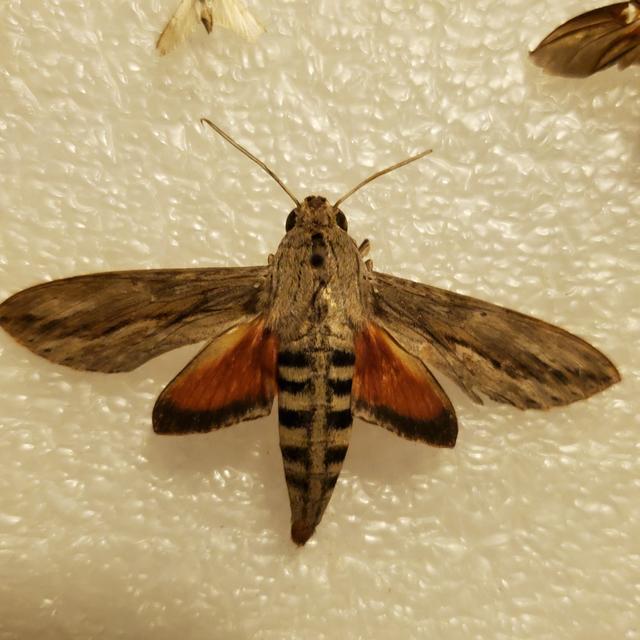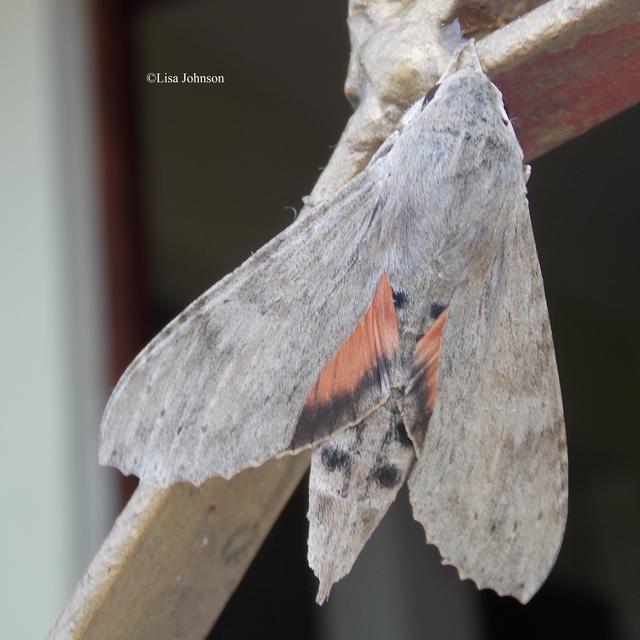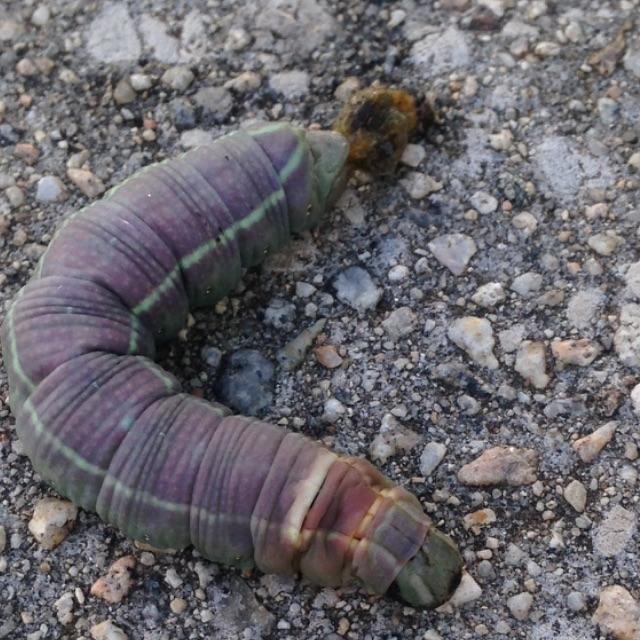Ello sphinx
Erinnyis ello (Linnaeus, 1758)
Family: Sphingidae
Subfamily: Macroglossinae
Identification: Abdomen has very distinct gray and black bands. Upperside of female forewing is pale gray with a few dark dots near the outer margin. Upperside of male forewing is dark gray and brown with a black band running from the base to the tip. In both sexes, the hindwing upperside is orange with a wide black border.
Wing Span: 2 15/16 - 3 5/16 inches (7.5 - 8.5 cm).
Life History: Adults begin feeding at dark. Fully-grown caterpillars spin cocoons on the soil surface.
Flight: . Several flights throughout the year in Florida and South Texas. Strays north July-October.
Caterpillar Hosts: Papaya (Carica papaya) in the Caricaceae family; various plants in the spurge family (Euphorbiaceae) including poinsettia (Euphorbia pulcherrima); guava (Psidium species) in the myrtle family (Myrtaceae); also saffron plum (Bumelia angustifolia) in the Sapotaceae.
Adult Food: Nectar from flowers including bouncing bet (Saponaria officinalis).
Habitat: Tropical and subtropical lowlands and foothills.
Range: Resident in Argentina north through Central America, Mexico, and the West Indies to south Florida, Texas, Arizona, southern California, and southern Nevada. Strays northward.
Conservation: Not usually required.
NCGR: G5 - Demonstrably secure globally, though it may be quite rare in parts of its range, especially at the periphery.
Management Needs: Ello sphinx caterpillars can be pests of poinsettias.
Get your BAMONA Gear!
Please donate!
We depend on donations to keep Butterflies and Moths of North America freely available. We want to express our gratitude to all who showed their support by making a contribution this year. You can donate to support this project at any time.
Advertise with us!
Do you have a product or service that you think would interest BAMONA users? If you would like to advertise on this website, contact us by email, or use the contact form and select the "Advertising" category.
Verified Sightings
Displaying 1 - 24 of 171 verified sightings

Observation date: Feb 08, 2025
Submitted by: LukaCustoms
Region: Miami-Dade County, Florida, United States
Verified by: curtis.lehman
Verified date: Feb 08, 2025

Observation date: Jan 08, 2025
Submitted by: bali
Region: Palm Beach County, Florida, United States
Verified by: John Calhoun
Verified date: Jan 08, 2025

Observation date: Apr 09, 2024
Submitted by: Pinknick304
Region: Miami-Dade County, Florida, United States
Verified by: curtis.lehman
Verified date: Apr 09, 2024

Observation date: Feb 07, 2024
Submitted by: Sue Bocchicchio
Region: Monroe County, Florida, United States
Verified by: curtis.lehman
Verified date: Feb 08, 2024

Observation date: Feb 04, 2024
Submitted by: marilynne
Region: Palm Beach County, Florida, United States
Verified by: curtis.lehman
Verified date: Feb 05, 2024

Observation date: Jul 08, 2015
Submitted by: Tim Norriss
Region: Camaguey, Cuba
Verified by: jwileyrains
Verified date: Jan 23, 2023

Observation date: Nov 13, 2015
Submitted by: Tim Norriss
Region: Holguin, Cuba
Verified by: jwileyrains
Verified date: Jan 23, 2023

Observation date: Apr 01, 2022
Submitted by: Mariadelaguardia
Region: Panama
Verified by: jwileyrains
Verified date: Jan 20, 2023

Observation date: Sep 18, 2021
Submitted by: bugboogie
Region: Broward County, Florida, United States
Verified by: curtis.lehman
Verified date: Oct 09, 2022

Observation date: Oct 27, 2016
Submitted by: LLJohnson
Region: Dominican Republic
Verified by: jwileyrains
Verified date: Oct 05, 2022

Observation date: Jul 20, 2014
Submitted by: LLJohnson
Region: Dominican Republic
Verified by: jwileyrains
Verified date: Sep 14, 2022

Observation date: Mar 24, 2020
Submitted by: JBSherwood
Region: Jalisco, Mexico
Verified by: jwileyrains
Verified date: Sep 12, 2022

Observation date: Oct 21, 2016
Submitted by: ujani
Region: Distrito Federal, Mexico
Verified by: jwileyrains
Verified date: Sep 12, 2022

Observation date: Mar 28, 2022
Submitted by: ZoeAlexa
Region: Palm Beach County, Florida, United States
Verified by: curtis.lehman
Verified date: Mar 30, 2022

Observation date: Sep 11, 2017
Submitted by: Clw40
Region: San Diego County, California, United States
Verified by: curtis.lehman
Verified date: Feb 21, 2022

Observation date: Sep 20, 2017
Submitted by: photoshack
Region: Orange County, California, United States
Verified by: curtis.lehman
Verified date: Feb 21, 2022

Observation date: Sep 11, 2017
Submitted by: Clw40
Region: San Diego County, California, United States
Verified by: curtis.lehman
Verified date: Feb 21, 2022

Observation date: Nov 02, 2015
Submitted by: lindaloi
Region: San Diego County, California, United States
Verified by: curtis.lehman
Verified date: Feb 21, 2022

Observation date: Oct 10, 2015
Submitted by: Kholshoe
Region: San Bernardino County, California, United States
Verified by: curtis.lehman
Verified date: Feb 21, 2022

Observation date: Sep 19, 2016
Submitted by: Idablankenship
Region: San Diego County, California, United States
Verified by: curtis.lehman
Verified date: Feb 21, 2022

Observation date: Oct 22, 2015
Submitted by: Lathie
Region: Los Angeles County, California, United States
Verified by: curtis.lehman
Verified date: Feb 21, 2022

Observation date: Sep 10, 2021
Submitted by: Amberlina
Region: San Diego County, California, United States
Verified by: jwileyrains
Verified date: Feb 20, 2022

Observation date: May 20, 1994
Submitted by: Allen B
Region:
Verified by: Allen B
Verified date: Feb 20, 2022

Observation date: Dec 24, 2013
Submitted by: CGerstle
Region: Florida, United States
Verified by: jwileyrains
Verified date: Feb 02, 2022
- 1 of 8
- next ›






